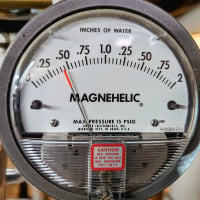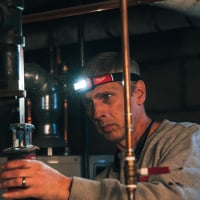Street 90 in gas piping
In the US, I can not find in the gas codes where it prohibits the use of a street 90.
The reasons I've seen for not using one do not make sense. Not at least with modern street 90s (if there is any difference).
Two 90s and a close nipple can not replace a 90 and street 90. Two 90s and a close nipple have a higher chance of not fully sealing then a street 90 and 90.
Unless prohibited by Code, there isn't any reason not to use a street 90.
Comments
-
Gas inspectors around here don't like them. And they don't like close nipples either. Or bushings.
All Steamed Up, Inc.
Towson, MD, USA
Steam, Vapor & Hot-Water Heating Specialists
Oil & Gas Burner Service
Consulting2 -
Only comment I've gotten is put the street on the top, plain ell on the bottom.
Guess that's because you cant ream a street. (?)
Trying to squeeze the best out of a Weil-McLain JB-5 running a 1912 1 pipe system.0 -
Bushings not allowed in MA where I am. I have never heard of a code that did not allow street 90s or close nipples, but I would avoid both if possible JMHO. I never used a street unless a nipple and two elbows were impossible. I would rather a close nipple than a street
I have seen specs written for commercial jobs where close nipples and street elbows are not allowed by the engineer.
0 -
You need to make sure you look at your local code specifically.
I see no mention in NJ's gas code of even bushings not being allowed, just cast iron bushings are not.
Cast iron bushings is #3. No mention of street 90s.
I'm really surprised other cast iron fittings are allowed. It does mention in another section that cast iron pipe is NOT allowed but I guess most fittings are.
@EBEBRATT-Ed Can you do a screenshot of where MA's code says no bushings are allowed at all?
@Steamhead I was told inspectors around here don't like plugs in tees, only a nipple and a cap. Yet, I see nothing in the code about it.
Single pipe 392sqft system with an EG-40 rated for 325sqft and it's silent and balanced at all times.
0 -
-
I think the issue that comes in to play with bushings is that when transitioning a single pipe size the inspector can't tell if it is cast iron or malleable, at least that's what they tell me (michigan). So we are allowed to use them but only for transitioning multiple sizes. Most guys just use couplings and nipples because it doesn't really make sense and the inspector can always just say he can't tell what type of bushing it is, kind of bogus.
0 -
-
Didn't think you could use compression on gas, at least on copper.
what is flareless?
0 -
Same with electrical as well.
They do what they want.
Single pipe 392sqft system with an EG-40 rated for 325sqft and it's silent and balanced at all times.
0 -
I am surprised NJ allows CI fittings. They are a no no here except I think there is some allowance for fittings over 4" and maybe CI flanges are ok …..will have to look.
Maybe some inspectors don't like plugs because plugs are CI except in small sizes where caps are usually malleable. I used to see some really old jobs with CI caps.
It can get confusing. MA does not allow any galvanized but other states do. MA adopts the NFPA 54 for Natural and 58 for propane but then they have a few pages of their own amendments
0 -
they have rules they have to follow also.
Now what Greenport power and light does isn’t allowed in Suffolk County
0 -
The utilities definitely have tons of rules and EO's that get followed (electric, gas and steam) but they do not line up with the code books that everyone else is guided by. I can't tell you how many times I was left scratching my head when we would install a #2/0 copper service and connect it to the electricians 600mcm copper or 2 sets of 500mcm copper cables. One side working on load cycles and the other side working on connected loads, big difference in the amount of copper required.
0 -
It is in open air so it isn't going to burn up but it seems like voltage drop would be an issue.
0 -
no i worked 36 years in Manhattan all underground work only 2 poles in the city none with services :). You'd be surprised to see what feeds some of those buildings, the calculation is done completely differently. They do run warm sometimes but it lasts for many, many years without issue so they get their monies worth out of it. I've taken the lead off of some of the cables we've replaced in the ground and some was almost a hundred years old.
0 -
-
i mean if you have eyes you can tell if both halves of a close nipple have several threads engaged
0 -
i don't see why a street ell would be any thinner than a piece of pipe
0 -
I think the thinking is that an inspector can't tell by looking whether it's fully engaged. I'm not saying I buy it.
0 -
All of these connections are expected to be pressure tested, no?
I don't think you can fit a wrench on most 1.5" nipples either there's usually no room. Can anyone post code from their area showing that street ells or close nipples are prohibited?
Single pipe 392sqft system with an EG-40 rated for 325sqft and it's silent and balanced at all times.
0 -
-
Them being questionable and likely to leak has been my experience as well.
Single pipe 392sqft system with an EG-40 rated for 325sqft and it's silent and balanced at all times.
0 -
My area has some of the more rigorous codes around for fuel gas. No street elbows, no nested bushings, no galvanized (i think they dropped that recently), no close nipples, no running thread couplings, no bent pipe. "Thread and screw up to two", weld and flange the bigger sizes. The utilities dont like bushings, plugs are frowned upon. Funny thing is the utilities take the running thread protectors from the lengths of bip and use them to assemble 5 6in nipples to avoid cutting a length of pipe. Ok for them, not ok for us. (Excessive use of nipples, running thread couplings, both code violations, iirc...)
1 -
What area is that?
Single pipe 392sqft system with an EG-40 rated for 325sqft and it's silent and balanced at all times.
0 -
This is what the Michigan residential fuel gas code says:
I think the 2003 version enumerated fittings like swing joints and unions and close nipples and bushings. Have to look at those ansi listings for a list of what is allowed now.
I assume for close nipples you would need an internal pipe wrench or 2 nuts locked together to remove it without damaging it. Sometimes you can grab the middle with channelocks. This is the reason I used longer nipples where I couldn't use street fittings or reducing fittings.
0 -
I have never heard of a street ninety not allowed. Not in a code book or local inspector has ever said to not use one.
Bushings? Never heard of a BCI bushing.
Many a gas company folks along with some inspectors will not allow for bushings on gas. A couple reasons given is because you can't see where a leak is coming from as the threads (male and female) on a bushing are too close together. Years ago, some installers would only use bushings on gas. The problem was that they would use bushings from two inch to three quarter inch or less. Picture that cone of bushings. This is another reason why reducing couplings are allowed and not bushings.
1 -
been using street ells with gas for decades. Obviously, streets are not the first choice, we use em when we need to
0 -
@Intplm. Most all bushings are CI excepth the smaller sizes. At least that is what the supply houses around here have. Small stuff 1/8-3/4 is usually sold in steel but sometimes cast. Larger stuff is always CI unless you order forged steel.
1 -
Wow. I have been purchasing steel all these years. Or at least thought I was. When I was working and ordering large big money material orders, no BCI bushings were specked out. And I never thought to look to see otherwise. Thanks for the heads up.
0
Categories
- All Categories
- 87.3K THE MAIN WALL
- 3.2K A-C, Heat Pumps & Refrigeration
- 61 Biomass
- 427 Carbon Monoxide Awareness
- 119 Chimneys & Flues
- 2.1K Domestic Hot Water
- 5.8K Gas Heating
- 115 Geothermal
- 165 Indoor-Air Quality
- 3.7K Oil Heating
- 76 Pipe Deterioration
- 1K Plumbing
- 6.5K Radiant Heating
- 395 Solar
- 15.6K Strictly Steam
- 3.4K Thermostats and Controls
- 56 Water Quality
- 51 Industry Classes
- 49 Job Opportunities
- 18 Recall Announcements








